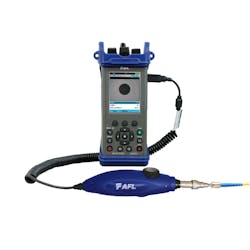Data center OTDR simplifies fiber installation, troubleshooting
AFL has introduced its Noyes M310 Data Center OTDR, specifically designed to address the technical challenges associated with data center architectures and network speeds.
According to AFL, the Noyes M310 OTDR combines short dead zones and generous dynamic range, enabling technicians to easily troubleshoot fiber runs abundant with connections and short jumpers. An integrated Visible Fault Locator provides a quick means of validating fiber polarity and identifying workmanship issues like broken, kinked or crushed fibers.
Further, all M310 models include an integrated OPM and when used in conjunction with OTDR Pass/Fail limits, provide the required functions for capturing accurate Tier 1 and Tier 2 loss measurements. Dirt and damaged fibers, which are often responsible for network outages, are quickly and easily inspected with the optional DFS1 Digital FiberScope.
The M310 also incorporates ease-of-use features including the company's Touch and Test user interface, Wave ID, Live Fiber Detection, Front Panel and First Connector Checks capabilities, which enable experts and novices to quickly and efficiently resolve network challenges characteristic of modern data centers.
The M310 is available in certification kits which provide all the tools necessary for cleaning, inspecting, Tier 1 and Tier 2 testing and documenting data center networks. The kits are available as multimode, single-mode or QUAD kits. The kit includes an M310 OTDR with integrated OPM and VFL, an Optical Light Source, a Digital FiberScope, TRM Test Results Manager and TRM 2.0 Basic, the PC companion reporting and analysis software package which can be used to create certification documents including loss tables, OTDR traces and end face images.
An Advanced Analysis software package which provides macrobend/microbend detection and bi-directional trace averaging is available as option. Macrobend/microbend detection can indicate installation problems due to crushed or stressed fibers in splice trays, cabinets and cable pathways. These losses can limit fibers from meeting the demands of current and emerging applications. Advanced Analysis software is available for the M310 and in TRM 2.0 Advanced Analysis.
Stating the value proposition of the new tool, AFL has the following to say: "Inherent in Top of Rack (TOR) and End of Row (EOR) data center configurations are ultra-short fiber links, numerous patch panels and cross-connections. At the same time bandwidth demand is accelerating the deployment of 40 and 100G Ethernet with concurrent reductions in optical budgets. Network uptime is critical in data center networks, and the ability to pinpoint faults to an end of a jumper cable and get the network back online is crucial."
"The M310 has industry leading specifications; including sub 1 m event and 2.5 m attenuation dead zones and integrated OTDR, OPM, VFL and inspection support. This enables technicians to test and characterize data center fibers as outlined in the ANSI 002-2011 Data Center Design and Implementation Best Practices," adds Michelle Collier, RCDD, senior product marketing manager at AFL.
Search for OTDRs in our Online Buyer's Guide
